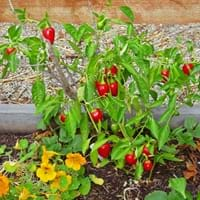Origin
South America, Micronesia, New Zealand
Mexico, Central America, South America
Types
Not Available
Not Available
Habitat
coastal environs, Grassland, Roadsides, Waste areas, waterways
Open areas
USDA Hardiness Zone
7-11
Not Available
AHS Heat Zone
11 - 7
12-1
Sunset Zone
H1, 3a, 3b, 4, 5, 6, 7, 8, 9, 10, 11, 12, 13, 14, 15, 16, 17, 18, 19, 20, 21, 22, 23, 24
A1, A2, A3, H1, H2, 1a, 1b, 2a, 2b, 3a, 3b, 4, 5, 6, 7, 8, 9, 10, 11, 12, 13, 14, 15, 16, 17, 18, 19, 20, 21, 22, 23, 24
Habit
Clump-Forming
Upright/Erect
Flower Color
Purple
White
Flower Color Modifier
Bicolor
Bicolor
Fruit Color
Not Available
Red, Green
Leaf Color in Spring
Green, Light Green, Dark Green
Dark Green
Leaf Color in Summer
Light Green
Green
Leaf Color in Fall
Green, Light Green, Dark Green
Green, Black
Leaf Color in Winter
Dark Green, Tan
Dark Green
Leaf Shape
Grass like
Ovate
Plant Season
Spring, Summer, Fall, Winter
Spring, Summer, Fall
Sunlight
Full Sun
Full Sun
Type of Soil
Loam
Loam, Sand
The pH of Soil
Acidic, Neutral
Neutral
Soil Drainage
Well drained
Well drained
Bloom Time
Summer, Fall
Spring, Summer, Indeterminate
Tolerances
Drought, Salt
Drought
Where to Plant?
Ground
Container, Ground
How to Plant?
Seedlings
Seedlings, Transplanting
Plant Maintenance
Medium
Medium
Watering Requirements
Average Water Needs
Do Not over Water
In Summer
Lots of watering
Lots of watering
In Spring
Moderate
Moderate
In Winter
Average Water
Average Water
Soil pH
Acidic, Neutral
Neutral
Soil Type
Loam
Loam, Sand
Soil Drainage Capacity
Well drained
Well drained
Sun Exposure
Full Sun
Full Sun
Pruning
Remove damaged leaves, Remove dead branches, Remove dead leaves
Remove damaged leaves, Remove dead branches, Remove dead leaves
Fertilizers
All-Purpose Liquid Fertilizer
All-Purpose Liquid Fertilizer
Pests and Diseases
Red blotch
Not Available
Plant Tolerance
Drought
Drought
Flower Petal Number
Single
Single
Foliage Texture
Fine
Medium
Foliage Sheen
Matte
Glossy
Attracts
Not Available
Not Available
Allergy
Itchiness
Hives, Rash
Aesthetic Uses
Showy Purposes
Showy Purposes
Beauty Benefits
Not Available
Not Available
Edible Uses
Sometimes
Yes
Environmental Uses
Air purification
Air purification
Medicinal Uses
Not Available
cholesterol-lowering, Low calories, Vitamin C
Part of Plant Used
Flowers, Leaves
Fruits
Other Uses
Animal Feed, Used as Ornamental plant
Used As Food
Used As Indoor Plant
No
No
Used As Outdoor Plant
Yes
Yes
Garden Design
Cutflower, Dried Flower/Everlasting, Feature Plant, Foundation, Groundcover, Mixed Border, Screening / Wind Break
Bedding Plant, Container, Edible, Herb / Vegetable, Mixed Border, Tropical
Botanical Name
CORTADERIA jubata
CAPSICUM annuum 'Cherry Bomb'
Common Name
Purple Pampas Grass
Cherry Bomb Pepper, Cherry Pepper
In Hindi
Purple pampas grass
Cherry Bomb Pepper
In German
Lila Pampasgras
Cherry Bomb Pfeffer
In French
Pourpre herbe de pampa
Cherry Bomb Pepper
In Spanish
hierba púrpura pampas
Bomba de cereza Pimienta
In Greek
Μωβ γρασίδι παμπάς
Cherry Bomb Πιπέρι
In Portuguese
grama roxa pampas
Cherry Bomb Pimenta
In Polish
Purpurowy trawa pampasów
Cherry Bomb Pepper
In Latin
Purpura Pampas herba
Cherry Bomb Pepper
Phylum
Magnoliophyta
Anthophyta
Class
Liliopsida
Eudicotyledones
Family
Poaceae
Solanaceae
Genus
Cortaderia
Capsicum
Clade
Angiosperms, Commelinids, Monocots
Angiosperms
Tribe
Not Available
Not Available
Subfamily
Not Available
Not Available
Number of Species
Not Available
Not Available
Importance of Purple Pampas Grass and Cherry Bomb Pepper
Want to have the most appropriate plant for your garden? You might want to know the importance of Purple Pampas Grass and Cherry Bomb Pepper. Basically, these two plants vary in many aspects. Compare Purple Pampas Grass and Cherry Bomb Pepper as they differ in many characteristics such as their life, care, benefits, facts, etc. Every gardener must at least have the slightest clue about the plants he wants to plant in his garden. Compare their benefits, which differ in many ways like facts and uses. The medicinal use of Purple Pampas Grass is Not Available whereas of Cherry Bomb Pepper is cholesterol-lowering, Low calories and Vitamin C. Purple Pampas Grass has beauty benefits as follows: Not Available while Cherry Bomb Pepper has beauty benefits as follows: Not Available.
Compare Facts of Purple Pampas Grass vs Cherry Bomb Pepper
How to choose the best garden plant for your garden depending upon its facts? Here garden plant comparison will help you to solve this query. Compare the facts of Purple Pampas Grass vs Cherry Bomb Pepper and know which one to choose. As garden plants have benefits and other uses, allergy is also a major drawback of plants for some people. Allergic reactions of Purple Pampas Grass are Itchiness whereas of Cherry Bomb Pepper have Hives and Rash respectively. Having a fruit bearing plant in your garden can be a plus point of your garden. Purple Pampas Grass has showy fruits and Cherry Bomb Pepper has showy fruits. Also Purple Pampas Grass is not flowering and Cherry Bomb Pepper is flowering. You can compare Purple Pampas Grass and Cherry Bomb Pepper facts and facts of other plants too.





